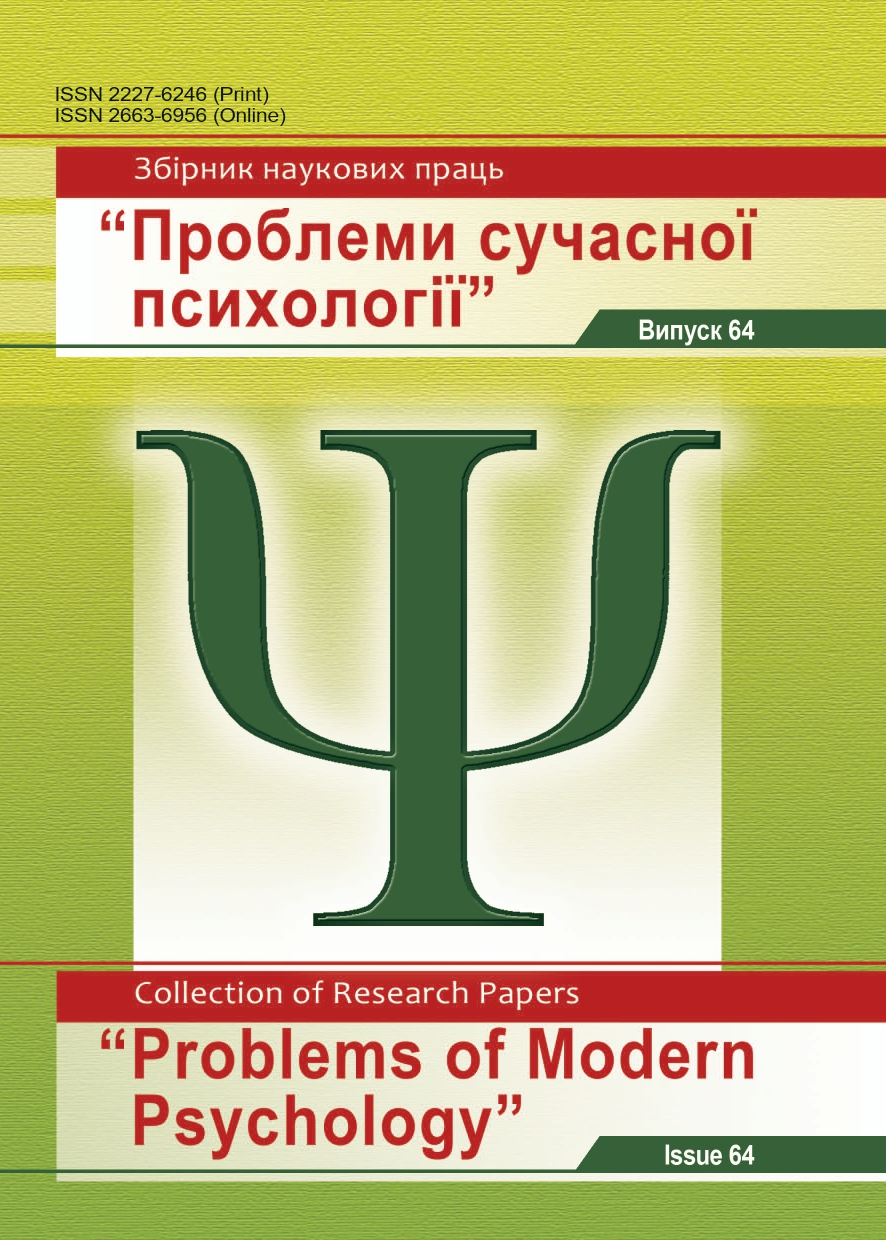Опитувальник саморефлексії: дискусійні результати змістовної валідності
DOI:
https://doi.org/10.32626/2227-6246.2024-64.270-302Ключові слова:
саморефлексія, особистісне самоздійснення, психологічні ресурси, реалістичність власного Я, внутрішня робота над собоюАнотація
Метою дослідження є емпіричне обґрунтування можливості психологічної діагностики саморефлексії як здатності особистості до самоздійснення.
Методи. Апробація опитувальника саморефлексії була реалізована шляхом оновлення даних надійності і валідності методики рефлексивності, яку було розроблено нами на теоретичній основі опису компонентів рефлексивності Л.І. Пономаренко. Для опису змістової валідності опитувальника саморефлексії було застосовано опитувальники екзистенційної здійсненності і особистісного самоздійснення, шкала саморефлексії і інсайту, шкала самооцінки, опитувальники психологічних ресурсів. Застосовані методи математико-статистичного аналізу: кореляційний, порівняльний, багатофакторний, класифікаційний, кластерний аналіз, аналіз причин та ефектів.
Результати дослідження. Підтверджено, що дескрипторами саморефлексії є такі: відстороненість, позитивна дисоціація, гностична компетентність, артикульованість, лабільність, оригінальність, критичність, когнітивність. Внутрішня узгодженість шкал опитувальника є високою (r=0,37-0,60; p < ,01)). Структуру восьми дескрипторів методики описує однофакторноа емпірична модель, що пояснює 57% дисперсії у групі. Найвпливовішими предикторами загального рівня саморефлексії виявлено такі, як лабільність (ранг 100), позитивна дисоціація (ранг 98), артикульованість (ранг 89), когнітивність (ранг 82). Виокремлено три типи саморефлексії. Визначено зв’язки дескрипторів саморефлексії і виявів самосвідомості (самооцінка, Я-концепція), також з особистісним екзистенційним самоздійсненням, психологічними ресурсами, показниками ціннісно-смислової сфери особистості. Результати змістової валідності дали змогу увиразнити виокремлений феномен емпіричної реальності як саморефлексію.
Висновки. Саморефлексію схарактеризовано як здатність суб’єкта до особистісного самоздійснення, способом впізнавання себе в результаті прийняття співвідношення власних інтерпретованих доступними можливостей та цілями бажаного психологічного благополуччя. Вказане співвідношення уможливлюється реалізацією внутрішньої роботи особи над собою, яка виявляється у зменшенні, як упереджено самообмежувального ставлення щодо здійсненності власних можливостей, так і авторитарно-егоїстичного ставлення щодо інших. Головним виявом саморефлексії є критичність, що задає співвідношення власних інтерпретованих можливостей і реалій наявної ситуації, за якого неупередженість суб’єкта надає йому змогу бути готовим «прочитати особисте послання» у наявних життєвих умовах. Виведено, що саморефлексія дає змогу особистості визначити реалістичну «версією самої себе» в результаті певного прожитого досвіду, тому функція саморефлексії є моніторинговою.
##submission.downloads##
Опубліковано
Як цитувати
Номер
Розділ
Ліцензія
Авторське право (c) 2024 Штепа Олена

Ця робота ліцензується відповідно до Creative Commons Attribution-NonCommercial 4.0 International License.
Редакція має повне право публікувати у Збірнику оригінальні наукові статті як результати теоретичних і експериментальних досліджень, які не знаходяться на розгляді для опублікування в інших виданнях. Автор передає редколегії Збірника права на розповсюдження електронної версії статті, а також електронної версії англомовного перекладу статті (для статей українською та російською мовою) через будь-які електронні засоби (розміщення на офіційному web-сайті Збірника, в електронних базах даних, репозитаріях та ін).
Автор публікації зберігає за собою право без узгодження з редколегією та засновниками використовувати матеріали статті: а) частково чи повністю в освітніх цілях; б) для написання власних дисертацій; в) для підготовки абстрактів, доповідей конференцій та презентацій.
Автор публікації має право розміщувати електронні копії статті (у тому числі кінцеву електронну версію, завантажену з офіційного web-сайту Збірника) на:
- персональних web-ресурсах усіх Авторів (web-сайти, web-сторінки, блоги тощо);
- web-ресурсах установ, де працюють Автори (включно з електронними інституційними репозитаріями);
- некомерційних web-ресурсах відкритого доступу (наприклад, arXiv.org).
Але в усіх випадках обов’язковою є наявність бібліографічного посилання на статтю або гіперпосилання на її електронну копію, що містяться на офіційному сайті Збірника.






